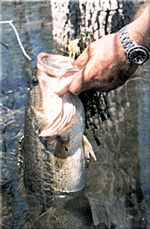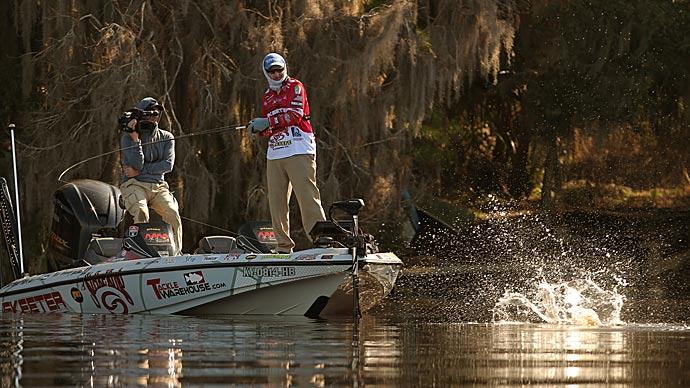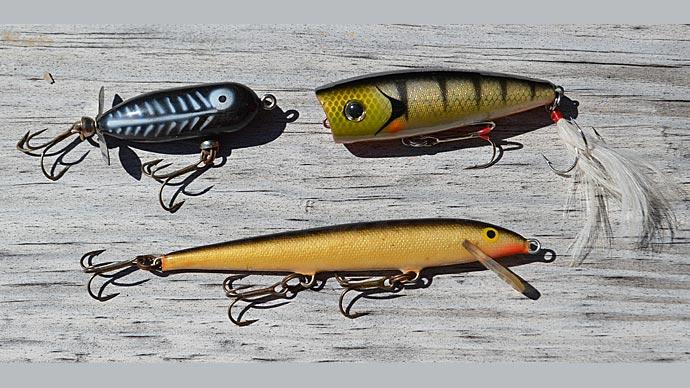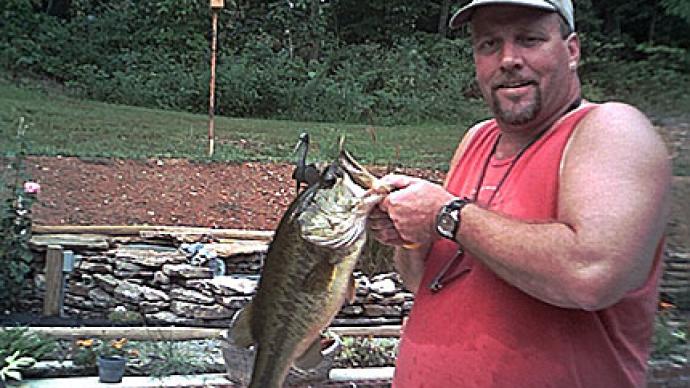
Buzzbaits are probably one of the most underutilized of all the topwater baits. They have been around for many years and, over time, have undergone various modifications. The old standby has one wing-type blade, with two, three, or four wings on the blade, and comes in metal or plastic. The purpose, of course, is to make a lot of noise and commotion on top of the water, which should attract a bass to strike the bait.
You can find buzzbaits that have a blade within a blade, jagged or stair-stepped blades, double or tandem blades, and even triple blades, but the basic design and intent are still the same. Some may have a clicker, ticker, or something to hit the blade to make a clicking sound, and some blades have holes or slots for making more "splash."
Buzzbaits, as the name implies, buzz or whirl across the top of the water. They are relatively easy to use. You just cast them out and reel them back at a steady medium retrieve. The catch is you need to start reeling as soon as the bait hits the water, especially if you're fishing over grass, hydrilla, or moss. Otherwise, the buzzbait will get tangled in the foliage and cause major headaches. The best way to cast a buzzbait is to throw it out underhanded or side-arm to keep it low to the water and out of the wind. Cast to the area you want to fish and start reeling when it hits the water. With your rod at 10:00 o'clock, this will get it up on top of the water fast.
Some anglers will go to extremes to get a buzzbait tuned how they want it to be. For example, holding them out the car window to break in the blade, so it squeaks just right, bending the blades to get a different action, or adding metal beads behind the blade to increase the noise will all impart slightly different modifications to each bait.
Popular sizes of buzzbaits are from 1/8- to ½-ounce. Some have aluminum, gold, and even bronze anodized aluminum blades. Some will have painted blades in white, chartreuse, black, and other colors. Then there are the plastic blades, which come in clear, chartreuse, white, and other variations. Each of these colors has its purpose, similar to other baits. Some are used on gray or overcast days, and some on bright sunny days.
The back of the bait generally has a lead head with a skirt that may come in white, chartreuse, white and chartreuse, black, and many other popular colors.
Some better areas to fish these baits are over aquatic growth-like grass, hydrilla, and moss or through the lily pads. Buzzbaits are not limited to these areas because they are good along the side of docks, in open water, down the bank, and through stumps or trees. And they will catch fish almost year-round but are particularly popular with most bass anglers in the spring and summer. Learning to use these baits to advantage means practice. And there's no better place to get that than on the lake. Experiment with direction by altering the way the bait runs. It can be helpful to have buzzbaits tuned to run right or left, depending on the variation you will need for the area you are fishing. But the key with buzzbaits will always be getting it on top and keeping it there for the longest possible time in the area you believe is holding fish.
Equipment used with this bait is also essential. The proper tool for changing a tire isn't for cleaning the windshield. It is the same in fishing. All of the reels, baitcasters, spin casters, or spinning reels will work, but for buzzbaits, a light medium or medium action 6 1/2 to 7 1/2-foot rod is the choice of most anglers. Line size is a personal preference, depending on the cover you are fishing, the size of bass you are pursuing, and maybe the time of year. The proper line selection will affect the distance you can cast based on lure size and the wind. The line can also give you an advantage over another angler. Heavy line, 20-, 25- or 30-pound test line will tend to float or help hold the bait on top of the water. But with smaller baits, like a 1/8-ounce buzzbait, you must drop down to 15-pound to help the bait have the proper action and reach your targeted casting zone. It will also help get the lure out of the water and buzzing quicker. Based on your choice of tackle, you can get a different reaction out of a buzzbait. I prefer 20-pound Trilene Big Game line on 1/4-ounce and larger baits, a 6-foot, 8-inch Falcon medium action Expert rod, and a Shimano Chronarch baitcasting reel.
You can add action to the bait by moving your rod from side to side as you retrieve the buzzbait. There are also many other tricks you can do to the bait to get various reactions from the retrieve. I won't give all my secrets away, but I will throw in this one. You can bend the wire in front of the blade to the right or left to get it to track off to the side and run up under a dock or in a pocket behind some lily pads. Sometimes this is all it takes to give you that edge to outwit the bass.
Noisy, splash-making topwater baits such as stickbaits are as crucial to your fishing arsenal as the buzzbait. In addition, mastering the cigar-shaped Zara Spook, chuggers, popping, or prop baits which are all dependent on you for the action to make them entice the bass, is extremely important this time of year.
The Spook-type bait gets its action by you holding the rod down towards the water and twitching it, in an inline motion about six to eight inches, while reeling a half a turn for each full twitch. It's like rubbing your tummy with one hand and patting your head with the other. It just takes lots of practice to get it down. It's called walking the dog. And knowing how to do it can help you catch fish.
The prop baits seem to be coming back because I've seen several new versions. Heddon's Wounded Spook, the Bass Pro Shops Extreme Twin Prop, and the Smithwick Devil's Horse have props on both ends of the bait. One of the original single prop baits is the Heddon Torpedo. Using prop baits is a no-brainer. You just cast them out and reel them back to the boat, and the props give off a noise and bubbles that attract the attention of bass. You can add action by slowing or stopping the retrieve and then starting again or moving your rod from side to side.
The Arbogast Jitterbug is another excellent topwater that has built-in action. The big-cupped metal blade on the front of the lure causes a large waddle from side to side. Then, as you crank it back, the action displaces water and produces a gurgling sound along with the waddle action to attract the bass.
I left my favorite topwater to the last. The popper or chugger baits have been around for years, like the Pop-R, but several newer versions or styles are available for our enjoyment.
Some of the popping or chugging baits are Berkley Bullet Pop Popper, the old standby the Rebel Pop-R, Excalibur Pop'n Image, Storm Chug Bug, Cultiva Gobo Popper, Yo-Zuri 3DB Series Popper, Rapala Skitter Pop, Bass Pro Shops Extreme Z-Pop and my favorite the Don lovino's Splash-It.
I use the Splash-It, 3DB, and Chug Bug the most in my fishing. The significant advantage of the Chug Bug is that it is both a walking-type bait like the Spook and a very effective chugger or popping bait. The Chug Bug comes in three sizes to cover most of your fishing needs in a topwater bait. In addition, the Flashtail (mylar) on the tail hook and the rattles help attract the bass. The Baby Bug is my first choice of the Chug Bugs, but I also use the regular Chug Bug. The key to these baits is to throw them out and let the bait sit until the water around the bait is still, then pop it twice, and wait again. When you start the popping action each time, it is usually when the bass will hit.
My favorite overall popper is the "Splash-it," I've had better luck with this topwater than any other. I feel the feathers on the tail hook are a significant factor that makes this bait so great. You fish the "Splash-it" like the other popping or chugging baits. One key is to slow down when fishing these topwater baits.
I use 12-pound Trilene Big Game line on these topwater baits, a 6-foot 8" medium action Falcon Expert and Curado 70 baitcaster for the walking type baits, and a light or medium light 6-foot, 9-inch, or 7-foot Falcon rod for the popping, 3DB and chugging baits. The 6 1/2 -footer on the walking bait is because I am only 5-foot tall, and you need to point the rod toward the water to work this bait (walking type) right. If you are taller, you maybe prefer a longer rod. The main thing is good tip action. Let the rod do all the work, or you'll wear yourself out.
These noisy, splashing topwater baits can be used successfully over grass, hydrilla, moss, and lily pads. They are also great around stickups, stumps, and rocky banks.
The standard for times of the year for each of these baits is as follows. Popper and chuggers are recommended for the later part of spring into summer. The prop-type baits are from the same period as the poppers. The stick or spook baits are used in post-spawn and the fall of the year. The Zara Spook is known to pull bass up 30 or 40 feet of water. The suggested time for buzzbaits is when the water temperature is over 70 degrees. It is also recommended to use these baits in still water to a light chop, not on a windy day.
Now I will tell you to take the standard or suggested uses and times and throw them out. Just use the information as that, information: then fish these baits whenever you feel the need. I've caught bass on all of these lures every month of the year. Don't be afraid to cast one of these topwaters under a tree or into heavy cover. If you don't get hung up occasionally, you're not fishing in the right places. You can also use these baits in open water, in the middle of the lake. Use your imagination to get outside the everyday thinking and catch more bass.
BassResource may receive a portion of revenues if you make a purchase using a link above.




